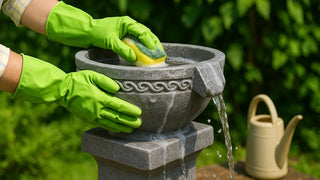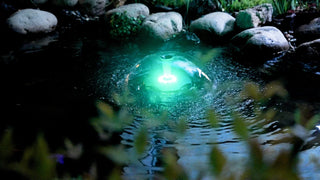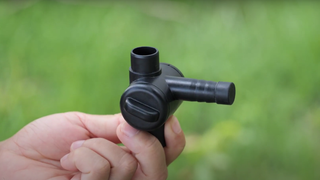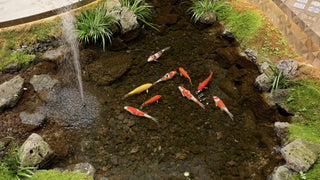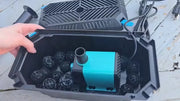
If your pond looks great but the waterfall sputters, the fountain mist barely rises, or the filter never quite keeps up, the culprit is usually the pump—not your design. Choosing the right engine for your water feature can mean the difference between a tranquil oasis and a weekly headache. This guide walks you through a practical, no-nonsense pump comparison so you can pick—with confidence—between a submersible pond pump and an external pond pump. Along the way, you’ll see where each shines, how to install and maintain them, and how Poposoap components slot neatly into real-world setups.
Differences Between The Two Types Of Pumps
Submersible pond pumps sit underwater, typically in the deepest zone, skimmer, or pump vault. The water naturally primes the impeller, so they’re plug-and-play: drop in, connect the hose, and go. They’re quiet (the pond muffles sound), compact, and easy to hide. Heat from the motor is dissipated directly into the water, which is fine in most climates but worth noting in shallow ponds during heatwaves. Because they live in the pond, they’re more exposed to debris and string algae, so a pre-filter or filter box is important for longevity.
External pond pumps are installed dry—outside the water line—often near the filter house, behind landscaping, or in a ventilated box. They can move a lot of water efficiently, especially at higher head heights, and are generally easier to service without getting wet. They do, however, require proper priming (or self-priming features), airtight plumbing on the suction side, and a secure, level base. Sound is more noticeable in the open air, so placement and vibration isolation matter. They also shed heat to the surrounding air rather than warming the pond.
As a mental model: if you want simple, hidden, and quiet, think submersible. If you want high, efficient flow to supply waterfalls, bottom drains, and multi-bay filtration, think external.
Comparison Of Advantages And Disadvantages

Submersible Pond Pump — Advantages
- Simplicity: Easiest to install and move. Great for first builds and small-to-mid ponds.
- Discreet: Lives underwater, so no clutter around the pond.
- Quiet operation: Water acts as a sound blanket.
- Solar-friendly: DC submersible pumps pair naturally with solar fountain and filter systems, and can be supported with battery packs for dusk or cloudy runs. Poposoap’s battery backups (1,800–5,200 mAh options) are designed to match a range of solar setups.
Submersible Pond Pump — Tradeoffs
- Debris exposure: More contact with leaves, silt, and algae; pre-filters and periodic cleaning are essential.
- Heat to water: Minor in most ponds, but consider shade and aeration in shallow or very warm climates.
- Service access: You’ll get your hands wet to retrieve and maintain it.
External Pond Pump — Advantages
- High, efficient flow at head: Excellent for taller waterfalls, long pipe runs, or when feeding multiple features and filters.
- Dry-side service: Maintenance without entering the pond; easier to add valves, unions, and baskets.
- Cooler water: No motor heat added to the pond.
External Pond Pump — Tradeoffs
- More setup details: Priming, airtight suction, and a stable, protected pad are musts.
- Visibility & sound: Needs thoughtful placement or screening.
- Weather exposure: Requires housing or shielding from rain and snow.
Recommended Usage Scenarios

Small Wildlife Or Patio Ponds (Simple Fountain Or Gentle Circulation).
If you’re building a compact water garden or bird-friendly bowl, a submersible is typically the best fit. A solar-powered submersible fountain pump makes installation almost tool-free and keeps wiring tidy. Poposoap’s solar fountain range scales from modest output up to robust performance—examples in the catalog include 50–70 W solar fountain sets rated up to ~360–680 GPH, suitable for mid-size features and taller nozzles.
Floating Display With Aeration And Lighting.
For ponds that need visual drama and extra oxygenation, a floating fountain brings spray patterns and integrated lighting without complicated plumbing. Poposoap’s floating fountain entry shows a 40 W pump, about 660 GPH, and a long cord for flexible placement—ideal when you want a centerpiece plus airflow across the surface.
Waterfalls And Higher Head Features.
Falls need steady flow against gravity. For short spillways, a stout submersible can work; for taller, longer runs—or split returns—an external pump shines. Poposoap waterfall kits document representative flow targets (e.g., around 660 GPH on compact falls and up to ~1,200 GPH on larger spans), which helps you size your pump to the visual you want.
Heavier Filtration And Multi-Stage Circulation.
If you’re feeding a mechanical+biological filter, UV clarifier, and a waterfall simultaneously, an external pump (or a submersible feeding an external filter box) can simplify plumbing and service. Poposoap’s plug-and-play pond filter kits illustrate typical throughputs around ~660 GPH, useful benchmarks when you’re balancing pump curves and filter resistance.
Solar-First Or Off-Grid Builds.
DC submersible pumps are purpose-built for solar, with battery packs to bridge clouds and evening. Poposoap’s DC water pumps cover a spectrum (3W–40W) to match panels and flows, offering flexible “mix and match” with their solar fountain/pond filter lines.
Analysis Of Installation And Maintenance

Submersible Basics.
Place the pump on a stable pad (flat stone or pump stand) above the very bottom to avoid silt ingestion. Always use a pre-filter—a sponge intake, skimmer basket, or a dedicated filter box with media—to protect the impeller from clogging and extend service intervals. Poposoap offers a filter box designed specifically to shield pumps and enhance filtration performance; it’s sold without a pump so you can pair it to your flow needs. Clean sponges and pads before they cake; never let the pump run dry.
External Best Practices.
Mount on a level slab with vibration pads. On the suction side, keep runs short and straight, use large-diameter pipe, and add a priming pot/strainer basket if your pump doesn’t include one. Install unions and ball valves on both suction and discharge for quick removal and flow balancing. Protect the pump with a ventilated, weather-resistant enclosure; keep it above flood level but below the water line if you rely on gravity prime. Always include a check valve to prevent backflow.
Electrical & Safety.
Use GFCI-protected circuits and outdoor-rated connections. For solar systems, follow polarity and connector guidance, and route cables where pets and kids won’t snag them. Poposoap’s accessories include extension cables sized for their solar pumps and filter systems to help with neat, safe routing.
Seasonal Care.
Before leaf-drop, add nets or skim more often so your pump doesn’t become a leaf shredder. In winter, either keep a small open hole with an aerator and run the system slowly, or shut down, drain exposed plumbing, and store the pump per the manufacturer’s directions. In freeze-prone regions, external pumps should be winterized; submersibles can be lifted, rinsed, and stored in a bucket of clean water in a frost-free area to keep seals supple.
Poposoap Adaptation Suggestions

If you like the Poposoap ecosystem—fountains, filters, aeration, waterfalls—their range makes it easy to build a coherent, maintainable system without mixing incompatible parts.
For Compact And Patio Ponds
Start with a Poposoap Solar Fountain Pump sized to your bowl or patio basin. The catalog shows options stepping up through 50, 55, and 70 W kits capable of roughly 360–680 GPH, which is plenty for lively spray patterns and shallow rills. On dim days or for evening ambience, add the matching battery backup capacity appropriate to your panel size so your feature doesn’t stall when clouds roll in.
For Mid-Size Ponds That Want A “Wow” Centerpiece
A Poposoap Floating Pond Fountain provides display aeration and built-in lights with an internal pump around 40 W / ~660 GPH, plus a long power cord for flexible placement—an elegant choice when you don’t want to re-plumb.
For Waterfall-First Landscapes
Pick a Poposoap Waterfall Kit sized to the spill width and drop. The catalog illustrates realistic flow targets (around ~660 GPH for compact lips and ~1,200 GPH for 24-inch spans). Use this to back-calculate your head and friction, and decide whether a robust submersible will suffice or whether an external pond pump makes more sense for sustained head pressure.
For Filtration-Led Builds
If water clarity is the priority, route your pump through a Poposoap Pond Filter Kit—the catalog shows representative systems around 40 W / ~660 GPH. It’s a helpful baseline for pump selection in a koi or goldfish setup where you want turnover in the 1–2× pond volume per hour range (adjust for fish load).
For Solar-Centric Or Off-Grid Routes
Choose a Poposoap DC Water Pump that matches your panel and flow target—options span 3 W, 10 W, 25 W, 30 W, 40 W, each intended to pair with corresponding solar fountain or pond-filter systems. Add the battery module sized for your wattage to carry you through shade and evening. This is the graceful path when you want sustainability and lower operating costs without sacrificing reliability.
For Serviceability And Add-Ons
If you prefer dry-side access, Poposoap AC pond pumps are a good foundation, and the lineup includes a version with UV—useful when you plan to integrate clarifiers and more robust plumbing.
Protect The Pump And Keep Maintenance Light.
Whichever direction you choose, consider Poposoap’s Filter Box with Filter Media as a pre-filter to keep leaves and sludge off the impeller; it’s designed to be paired with your chosen pump and improves filtration performance.
Bottom line: for most homeowners, a submersible is the right first pump—quiet, hidden, and straightforward. When your design grows taller, your plumbing gets more complex, or you want dry-side access and long-run efficiency, an external pond pump becomes the smart upgrade. Use this pump comparison to map your needs, then size your flow to the look you want (and the filter you need). With the Poposoap ecosystem—solar fountain kits, filter kits, floating fountains, DC and AC pumps, and accessories—you can build a clean, cohesive system that’s easy to live with, whether you want a whisper-quiet patio bowl or a bold, all-season waterfall.





